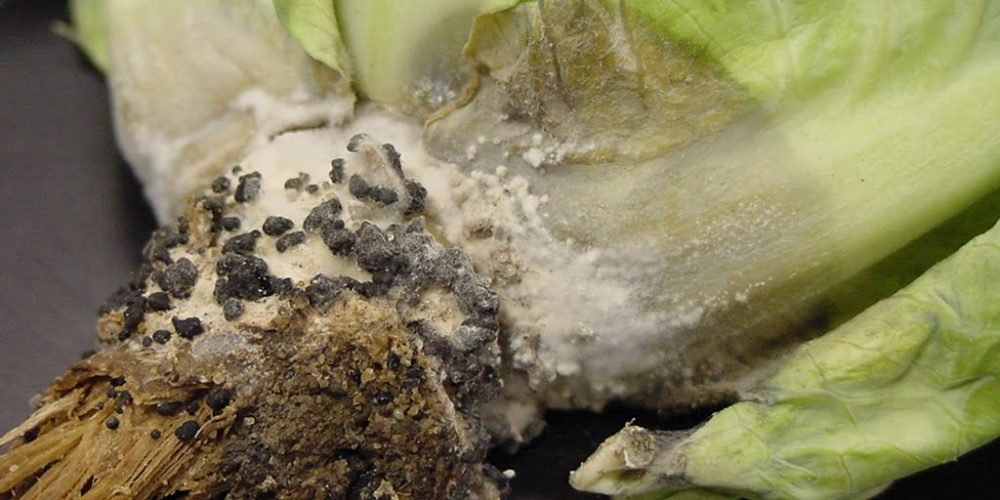#white_mold_on_lettuce
Sclerotinia White mold in Lettuce:
Scientific name: Sclerotinia sclerotiorum
Type of disease: fungal
A dangerous and widespread fungal disease that affects a large number of vegetable plants in greenhouses and the field in all temperate, cold, humid and even dry regions of the world. It can infect all parts of the plant (roots, stem, leaves, flowers, fruits, and roots) at any stage of growth, including seedlings and the growth stage. It is active during the production stage and during storage. It is considered a devastating disease for stored vegetables and causes significant losses during long storage, as infection with white mold is followed by infection with soft mold.
Its main feature is the production of black bodies (Sclerotia) and white mycelium. The black bodies (Sclerotia) are located at a depth of 2 cm from the soil surface.
The disease spreads easily through infected plant debris, agricultural equipment, rain, air currents, and host weeds. It is transmitted from host plants adjacent to the cultivated crop. This disease has a large number of host plants distributed in 64 plant families, 225 plant genera, and 408 plant species.
Pathogen:
Sclerotina mushroom:
Sclerotinia sclerotiorum
S.minor
Cause of disease:
The fungus causes white mold on many vegetable plants, with some differences between them in the life cycle, as the latter causes direct infection of plants from infected tissues, while the former rarely infects plants directly, forming fruiting bodies on the surface of the soil called apothecia that produce spores that are transmitted by wind and rain, and the infection comes from outside the field. .
The second sclerotia is small, with a diameter of 1/16-1/8 inch, while the first sclerotia is large, with a diameter of 1/2 inch and has an irregular shape. Scleroitum cepivorum infects the lily family, onions, garlic, and others. It infects and grows on the roots of onion and garlic plants, which leads to their rot and thus causes the leaves to turn yellow and cause the roots to rot.
The fungus can survive in the soil for many years in the form of sclerotia throughout the winter, and the infection begins with the germination of these black masses (sclerotia), which give fruiting bodies, and the formation of apothecia, which give hundreds of thousands of ascospores. With the availability of appropriate moisture and temperature under the vegetation, the spores germinate on Infected germination tissue gives mycelium. Germination on leaves can only occur in the presence of free water such as rain, spray irrigation, and dew. Cotton white fungus disease will develop on the infected tissue, sometimes accompanied by the formation of sclerotia when humidity conditions allow this.
Host plants for white mold:
It infects all plants of the cucurbit family, the legume family, eggplant, cabbage, strawberry, basil, tarragon, mint, lettuce, sunflowers, canola, and tobacco. Mold has one infection cycle in the same season.
# Conditions suitable for mushroom growth:
The disease develops under moderate temperatures and humid conditions, and with the leaves remaining wet for long periods (12-24 hours), which is optimal for the development of the disease. White mold prefers relatively low temperatures between 8 and 20 degrees Celsius, and white mold can remain in the soil for 8-10 years. To reach 15 years.
life cycle:
After a period of acclimatization in a sub-saturated, relatively cool environment (10 to 20°C), soil-borne sclerotia of S. sclerotiorum located 2 cm from the soil surface results in the production of apothecia and ascospores. Most often, this occurs after a heavy rain or irrigation event, and is aided by a shady, slow-drying soil surface. Ascospores are forcefully discharged ( Fig. 14 ) and transported by air currents to sensitive tissues. Long periods of leaf moisture (16 to 48 hours) with temperatures ranging from 12 to 24°C promote ascospore germination and infection. Because ascospores of S. sclerotiorum lack the energy to directly infect healthy host tissues, highly susceptible “weak” host tissues, such as flower petals or senescent leaves, are usually the first tissues to become infected. The colonized “weak” tissue serves as a nutritional base for the mycelium to grow with enough energy to penetrate healthy plant parts. As a result, major infection events often coincide with flowering and post-flowering periods, when senescent petals typically fall off and lodge in branch axils or attach to leaves, petioles, stems and developing fruits. With sufficient wetness, the mycelium moves from colonized tissues to robust host tissues such as stems, leaves, pods, etc. Later in the disease process, sclerotia form, either on the surface of the plant or within the stems and other parts of the plant. When a plant or plant part dies, the sclerotia fall into the soil where they can survive for several years. In some cases, such as cabbage plants and tobacco seedlings, Ascospores are able to infect plants through wounds. In these cases, S.sclerotiorum mechanical or chemical injury, insect feeding, or freezing can increase the incidence and severity of white mold.
#Symptoms
Early symptoms of the disease are in the form of areas submerged in water at the base of the plant stem at the level of the soil surface, which expand irregularly and indefinitely. When the infection expands, the stem curls and appears in the form of wilting, yellowing of the leaves, and death in tomatoes, cucumbers, legumes, and others, and at the base of the leaves in lettuce, dandelion, and carrots.
The disease begins early during the flowering period, especially in legumes, where the fungus feeds on the flowers.
With the continued presence of moisture, white cottony growth appears at the base of the plant and in other parts. The white mycelium grows very quickly and infects large areas during harvest.
This fungus infects the stem at the soil level, and infects the leaves, flowers, and fruits.
The first symptoms of the disease are cottony white growths on the affected tissue. As the disease progresses, the color of the plant gradually turns yellow, then brown, and may die. When the infected stem is cut, the fungus can be seen in the marrow as large black formations (6-12 mm).
The infected fruit grows with white fungus and becomes soft and watery.
The fungi produce enzymes and oxalic acid that cause hydrolysis in infected tissues.
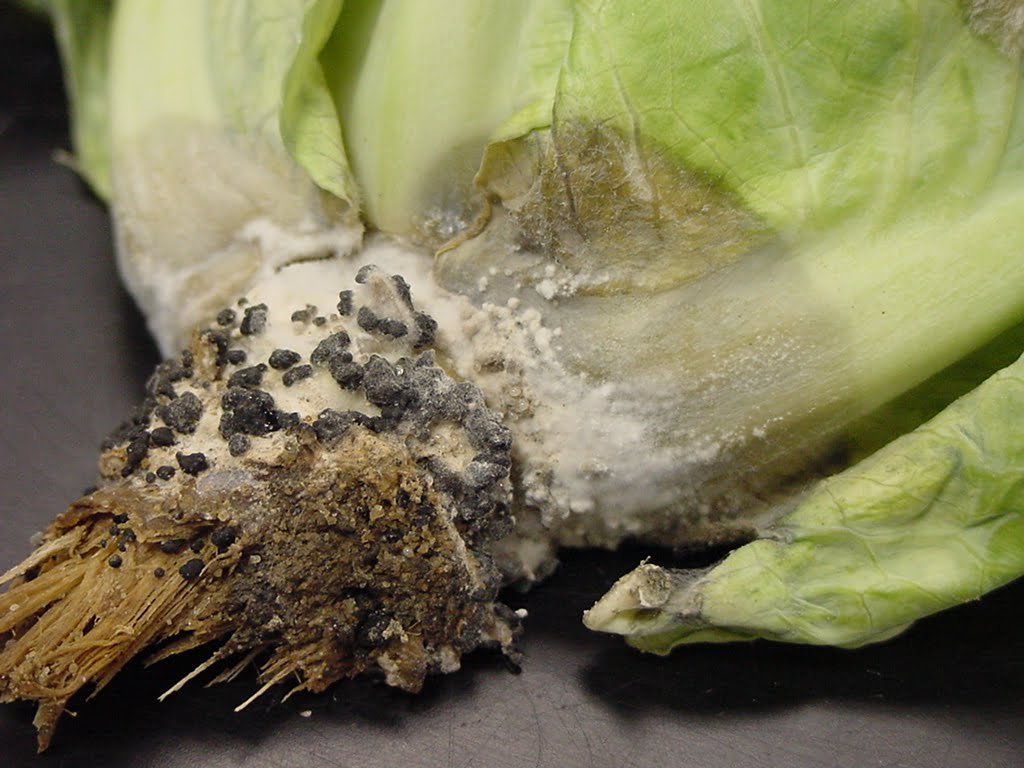
Image: White mold on lettuce. Notice the white fungal growth and black sclerosis that develops at the base of the stem. Sclorotia can survive in soil for up to 10 years
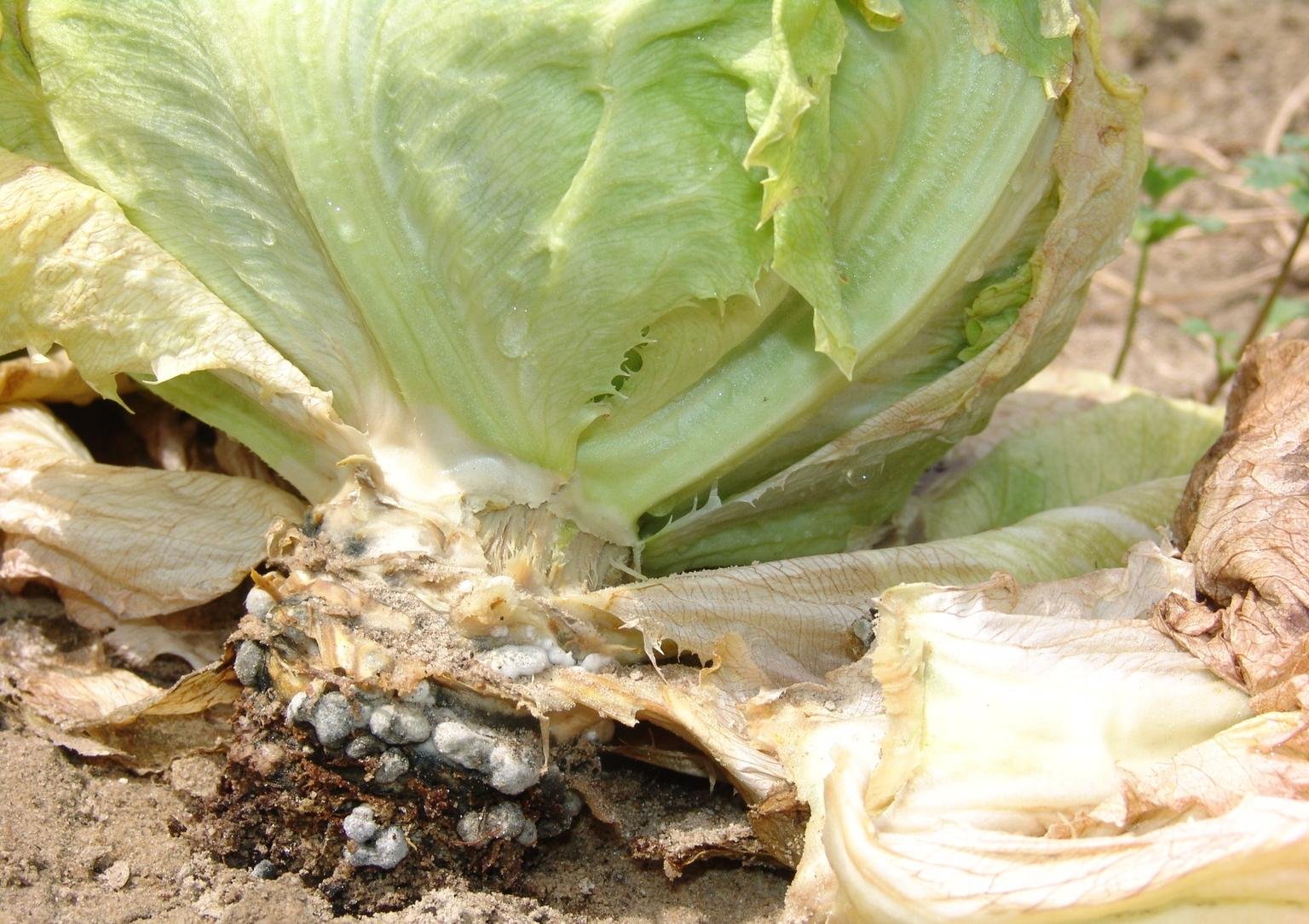
Image: showing the symptoms of white mold on lettuce
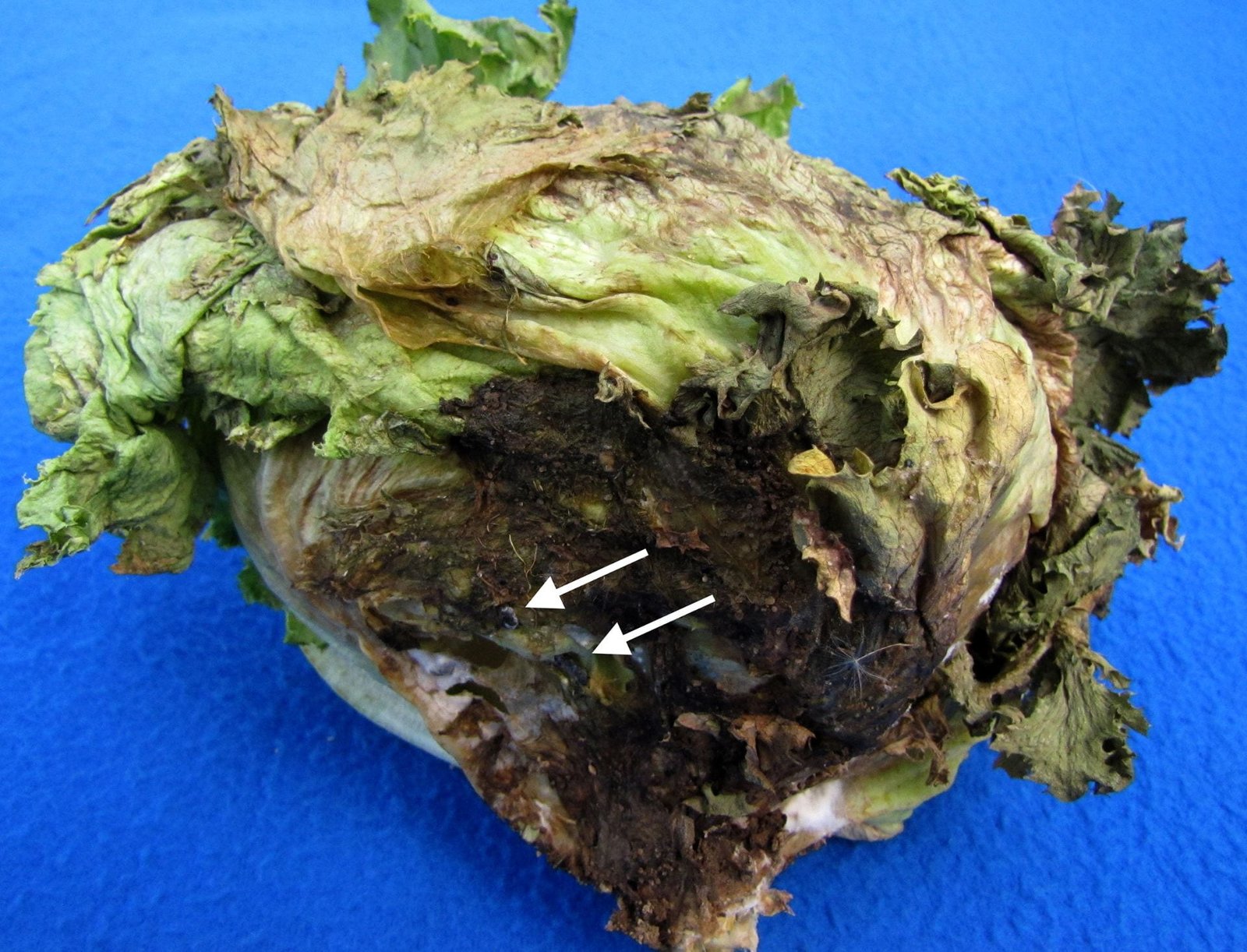
Image: showing the severe spread of white mold disease on lettuce
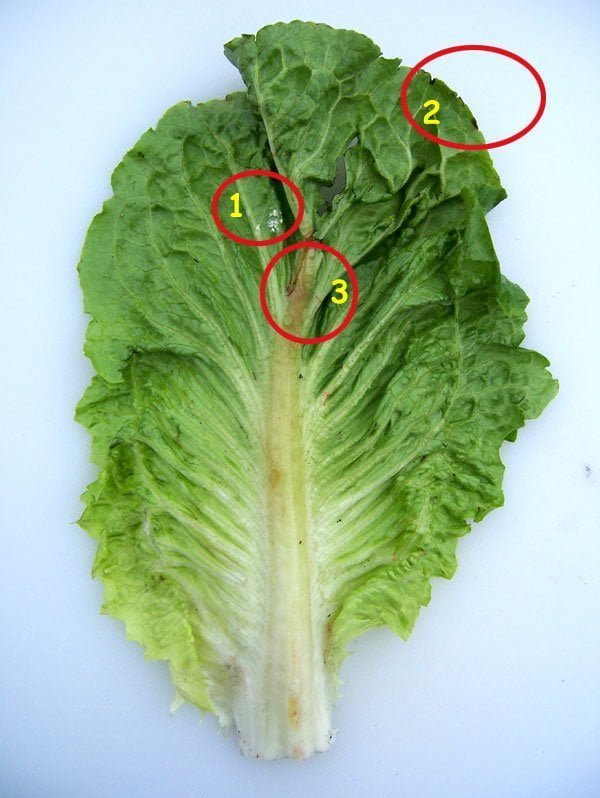
An image showing a group of diseases on lettuce, where number 1 represents the symptoms of white mold and number 2 represents the progression of the disease so that the color changes to brown
#Preventive measures:
It is easier and more cost-effective to overcome the infestation by controlling the disease in its early stages with the following preventive measures:
1 – Plant waste must be removed before planting, especially infected plants, by burying them.
2 - Deep plowing of the soil after the previous crop to help reduce this disease. It can be buried in sclerotina, and it is preferable to bury it up to 25 cm or more, as sclerotina that is buried deeply does not germinate and is eliminated by soil organisms. This method is effective against the pathogen S. minor. More than the fungus Sclerotinia sclerotiorum.
Although fungal spores remain in the agricultural layer for several years, only spores located near the soil surface can germinate and cause infection. Therefore, burying plant waste prevents infection from one season to another, and the cultivation process can return the spores to the soil surface and germinate, so by planting a non-host plant such as corn and grains. Reduces its numbers for the next season.
3 - Do not plant the same crop repeatedly in the same land for 3-5 years, while not planting host plants. Grains and corn can be grown in the agricultural cycle because they are not sensitive to the disease.
Because repeated cultivation of the same crop leads to an outbreak of the disease after a year and the soil becomes severely contaminated.
Even in the absence of a host, white mold spores can remain in the soil for five years in the planting layer and can germinate, but without subsequent infection.
If their number is low in the soil, an agricultural cycle of 3-5 years without a host is considered sufficient.
4 - Soil disinfection (as mentioned in a previous article) where solar disinfection of the soil (solarization or pasteurization) can be carried out in sunny areas by covering the prepared and moistened soil with a polyethylene cover with a thickness of 35-50 microns and keeping it in place for at least one month during A sunny period of the year, which helps eliminate white mold in the surface layer of the soil.
5 - Getting rid of weeds. There is a wide range of host weeds, so their presence in the field provides pollen for a host crop. Failure to get rid of weeds reduces the benefit of crop rotation.
Host herbs include mustard, vetch, shepherd's purse, and wild eggplant.
6 - Provide sufficient space for plants, avoid increasing plant density, and increase row spacing between plants in order to allow light to penetrate and to encourage rapid drying of leaves and fruits on wet days.
7 - Cultivation in terraces in conditions of continuous and successive rains.
8 - Avoid heavy nitrogen fertilization and do not exceed the required limit in order to avoid increasing the size of the vegetative system. .
9 – Good soil drainage. The presence of stagnant water will promote the spread of white mold.
10 - Improving air movement between plants to make the local climate of plants less suitable for infection in order to reduce humidity and speed up the drying of plant leaves.
11 - Drip irrigation is the best method of irrigation, and morning irrigation is preferred. If the field is irrigated with sprinklers, the number of irrigation times and the spacing between irrigations must be reduced by performing morning irrigation every 24 hours in the early morning and stopping irrigation before noon.
12 – Other humidity reduction techniques (during growth) include covering the ground with polyethylene sheets to reduce evaporation from the soil and help insulate plants from the soil.
13 - Monitor the field regularly, weekly, to identify the presence of white mold.
Organic control:
Contans is a commercial formulation of the pathogenic fungus S. sclerotiorum sclerotia, and may reduce the incidence and/or severity of white rot if applied to soil over many years.
Avoid excessive watering and fertilization that results in dense, lush canopies suitable for white mold. Promote air movement within the canopy by planting varieties with a smaller, upright structure, planting rows parallel to the prevailing wind direction, and planting them with wider row spacing. These practices will reduce the duration of leaf and soil moisture and may help reduce white mold in semi-arid production areas. If possible, use drip irrigation or a watering schedule to prevent continued moisture in the leaves and soil. Incorporate crop debris deeply to bury sclerotia.
#Chemical control:
Previous agricultural measures must be accompanied by chemical treatment when white mold conditions are expected (such as humidity). Resorting to the application of fungicides. The number of applications required varies according to the type of crop and the growing environment.
You should not use products containing the same active ingredient in successive treatments. If you choose to use fungicides, you must ensure that they belong to different groups to prevent the pathogen from developing resistance to certain chemicals.
The following are fungicides used in one or more regions of the world. When applying the fungicide, the plant must be completely covered early in the plant’s life and before the plant reaches the stage of complete soil coverage:
Rizolex-T and Topsin-M at 200 ppm
Ridomil MZ 72 WP (metalaxyl 8%+mancozeb 64%)
Ridomil gold,
Benlate,
Tecto-60
Topsin-M.
Pyrimethanil,
Cyprodinil + fludioxonil,
Benomyl,
Thiram,
Iprodione,
Procymidone,
Vinclozolin,
Carbendazim
Biological control:
All of the following have been used successfully in biological control:
Coniothyrium minitans;
Sporidesmium sclerotivorum.
Trichoderma hamatum.
the reviewer:
Bennett, J. Michael; Rhetoric, Emeritus; Hicks, Dale R.; Naeve, Seth L.; Bennett, Nancy Bush (2014). The Minnesota Soybean Field Book (PDF). St Paul, MN: University of Minnesota Extension. p. 81. Retrieved 21 February 2016.
Agrios, George N. Plant Pathology. 5th ed.. Burlington, MA: Elsevier Academic Press, 2005. 546-550. Print.Pohronezny, KL “White Mold.” Compendium of Tomato Diseases. 1st ed. St. Paul, MN: The American Phytopathological Society, 1991. Print.Pernezny, K, M. T Momol, and C. A Lopes. “White Mold.” Compendium of Pepper Diseases. 1st ed. St. Paul, MN: The American Phytopathological Society, 2003.
Abawi, G.S., and R.G. Grogan. 1979. Epidemiology of diseases caused by Sclerotinia spp. Phytopathology 69:899-904.
Adams, P. B., and W. A. Ayers. 1979. Ecology of Sclerotinia spp. Phytopathology 69:896-899.
Atallah, Z. K., B. Larget, X. Chen, and D. A. Johnson. 2004. High genetic diversity, phenotypic uniformity, and evidence of outcrossing in Sclerotinia sclerotiorum in the Columbia Basin of Washington state. Phytopathology 94:737-742.
Bradley, CA, RA Henson, PM Porter, DG LeGare, LE del Rio, and SD Khot. 2006. Response of canola cultivars to Sclerotinia sclerotiorum in controlled and field environments. Plant Disease 90:215-219.
Butzler, T. M., J. Bailey, and M. K. Beute. 1998. Integrated management of Sclerotinia blight in peanut: Utilizing canopy morphology, mechanical pruning, and fungicide timing. Plant Disease 82:1312-1318.
Clarkson, J.P., K. Phelps, J.M. Whipps, C.S. Young, J.A. Smith, and M. Watling. 2007. Forecasting Sclerotinia disease on lettuce: a predictive model for carpogenic germination of Sclerotinia sclerotiorum sclerotia. Phytopathology 97:621-631.
Gerlagh, M., H. M. Goossen-van de Geijn, N. J. Fokkema, and P. F. G. Vereijken. 1999. Long-term biosanitation by application of ConIothyrium minitans on Sclerotinia sclerotiorum-infected crops. Phytopathology 89:141-147.
Hao, JJ, KV Subbarao, and JM Duniway. 2003. Germination of Sclerotinia minor and S. sclerotiorum sclerotia under various soil moisture and temperature combinations. Phytopathology 93:443-450.
Hao, JJ, KV Subbarao, and ST Koike. 2003. Effects of broccoli rotation on lettuce drop caused by Sclerotinia minor and on the population density of sclerotia in soil. Plant Disease 87: 159-156.
Hollowell, J.E., B.B. Shew, M.A. Cubeta, and J.W. Wilcut. 2003. Weed species as hosts of Sclerotinia minor In peanut fields. Plant Disease 87:197-199.
Kolkman, J.M. and J.D. Kelly. 2002. Agronomic traits affecting resistance to white mold in common bean. Crop Science 42:693-699.
Livingstone, D. M., J. L. Hampton, P. M. Phipps, and E. A. Grabau. 2005. Enhancing resistance to Sclerotinia minor in peanut by expressing a barley oxalate oxidase gene. Plant Physiology 137:1354–1362.
Mueller, D. S., A. E. Dorrance, R. C. Derksen, E. Ozkan, J. E. Kurle, C. R. Grau, J. M. Gaska, G. L. Hartman, C. A. Bradley, and W. L. Pedersen. 2002. Efficacy of fungicides on Sclerotinia sclerotiorum and their potential for control of Sclerotinia stem rot on soybean. Plant Disease 86:26-31.
Otto-Hanson, L., J. R. Steadman, R. Higgins, and K. M. Eskridge. 2011. Variation In Sclerotinia sclerotiorum bean isolates from multisite screening resistance locations. Plant Disease 95:1370-1377.
Njambere, E.N., W. Chen, C. Frate, B.M. Wu, S. R. Temple, and F. J. Muehlbauer. 2008. Stem and crown rot of chickpea in California caused by Sclerotinia trifoliorum. Plant disease 92:917-922
Nelson, B., and A. Lamey. 2000. Sclerotinia diseases of sunflower. North Dakota State Extension Service Bulletin PP-840.
Pethybridge, S. J., F. S. Hay, and D. H. Gent. 2010. Characterization of the spatiotemporal characteristics of Sclerotinia flower blight epidemics in a perennial pyrethrum pathosystem. Plant Disease 94:1305-1313
Subbarao, K. V., S. T. Koike, and J. C. Hubbard. 1996. Effects of deep plowing on the distribution and density of Sclerotinia minor sclerotia and lettuce drop incidence. Plant Disease 80:28-33.
Workneh, P. and X. B. Yang. 2000. Prevalence of Sclerotinia stem rot of soybeans in the north-central United States In relation to tillage, climate, and latitudinal positions. Plant Disease 90:1375-1382.
Wu, B. M. and K. V. Subbarao. 2006. Analyses of lettuce drop incidence and population structure of Sclerotinia s Selected References
Sclerotinia spp. Abbawi, J. S. and R. J. Grogan, 1979. Epidemiology of diseases caused by Plant Pathology 69, 899-904.
The prosecution. Plant Pathology 69 9 Sclerotinia Ayers. 1979. Ecology of WA and PB Adams 899-896.
Atallah ZK, B. Large x. Chen, D. A. Johnson 2004 High genetic diversity in the Columbia Basin Sclerotinia sclerotiorum, phenotypic uniformity, and evidence for hybridization in Washington state. Plant Pathology 94 737-742
Bradley, C. A., R. A. Henson, P. M. Porter, D. J. Legare, L. D. Río, and S. D. Khot. In controlled environments Erotinia sclerotiorum 2006 Response of canola varieties to the disease. And the field. Plant Pathology 90: 215-219
Butzler, T. M. J. Bailey, and M. C. Beauty 1998. Integrated management of Sclerotinia blight in peanut: utilizing canopy morphology, mechanical pruning, and fungicide timing. Plant Pathology 82 1312-1318
Clarkson JBK. Phelps, J. M. Webbs, C. S. Young, J. A. Smith, and M. Watling. On lettuce: a predictive model for carbogenic germination of Sclerotinia 2007 Prediction of Sclerotinia sclerotiorum sclerotia 631-621 97 Plant Pathology
Gerlagh, M., H. M. Goossen-van de Geijn, N. J. Fokkema, and P. F. G. Vereijken. Long-term biosanitation by application of Minitan coneutherium on 1999.
Plant pathology:141189-147. Sclerotinia sclerotiorum Crops infected with
S and Sclerotinia minor. Howe, G. K. V. Subbarao, and J. M. Duniway. 2003. Germination under different combinations of soil moisture and temperature. Plant Pathology Sclerotiorum Sclerotia 93 443-450
Hao, J. J., K. V. Subbarao, and S. T. Koike 2003. Effect of broccoli rotation on leaffall and population density of Sclerotinia minor, a disease caused by lettuce.



